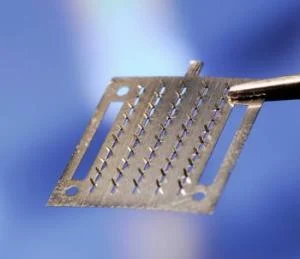 |
| Microneedle patch. (Credit: Image courtesy of Emory University ) |
Recent research found that microneedle vaccine patches are more effective at delivering protection against influenza virus in mice than subcutaneous or intramuscular inoculation. A new, detailed analysis of the early immune responses by the Emory and Georgia Tech research team helps explain why the skin is such fertile ground for vaccination with these tiny, virtually painless microneedles.
The research was published was recently published in the online journal MBio.
The skin, in contrast to the muscles, contains a rich network of antigen-presenting cells, which are immune signaling cells that are essential to initiating an immune response. The researchers found that microneedle skin immunization with inactivated influenza virus resulted in a local increase of cytokines important for recruitment of neutrophils, monocytes and dendritic cells at the site of immunization. All these cells play a role in activating a strong innate immune response against the virus.
Microneedle vaccination also may lead to prolonged depositing of antigen -- the viral molecules that are the targets of antibody responses. Such a prolonged antigen release could allow more efficient uptake by antigen-presenting cells. In addition, activated and matured dendritic cells carrying influenza antigen were found to migrate from the skin- an important feature of activating the adaptive immune response.
The research was led by first author Maria del Pilar Martin, PhD and Richard W. Compans, PhD, Emory professor of microbiology and immunology. Other authors included William C. Weldon, Dimitrios G. Koutsonanos, Hamed Akbari, Ioanna Skountzou, and Joshy Jacob from Emory University and Vladimir G. Zarnitsyn and Mark R. Prausnitz from Georgia Tech.
"Our research reveals new details of the complex but efficient immune response to influenza virus provided by microneedle skin patches," says Compans. "Despite the success of vaccination against influenza, the virus has many subtypes, mutates rapidly and continues to elude complete and long-term protection, and therefore requires annual vaccination with an updated vaccine each year.
"New vaccine formulations and delivery methods such as vaccine-coated microneedle patches could provide an improved protective response, which would be of particular benefit to those at high risk of related complications.
Vaccine delivery to the skin by microneedles is painless, and offers other advantages such as eliminating potential risks due to use of hypodermic needles."
The studies were supported by grants from the National Institute of Allergy and Infectious Diseases (NIAID) and the National Institute of Biomedical Imaging and Bioengineering, which are part of the National Institutes of Health. Dr. Martin was supported by a fellowship from the Emory/UGA Influenza Pathogenesis and Immunology Research Center, a NIAID Center of Excellence for Influenza Research and Surveillance.

Mais um avanço na cada vez mais desejada vacina universal contra o muito mutável vírus da gripe que mata anualmente entre 250 e 500 mil pessoas, sem contar com as pandemias uma das maiores ameaças à Humanidade.
ResponderEliminarÉ através destas pequenas inovações que um dia se chegará ao resultado esperado, já diz o ditado português "Grão a grão enche a galinha o papo"...
Ass: Paulo Machado
Eliminar